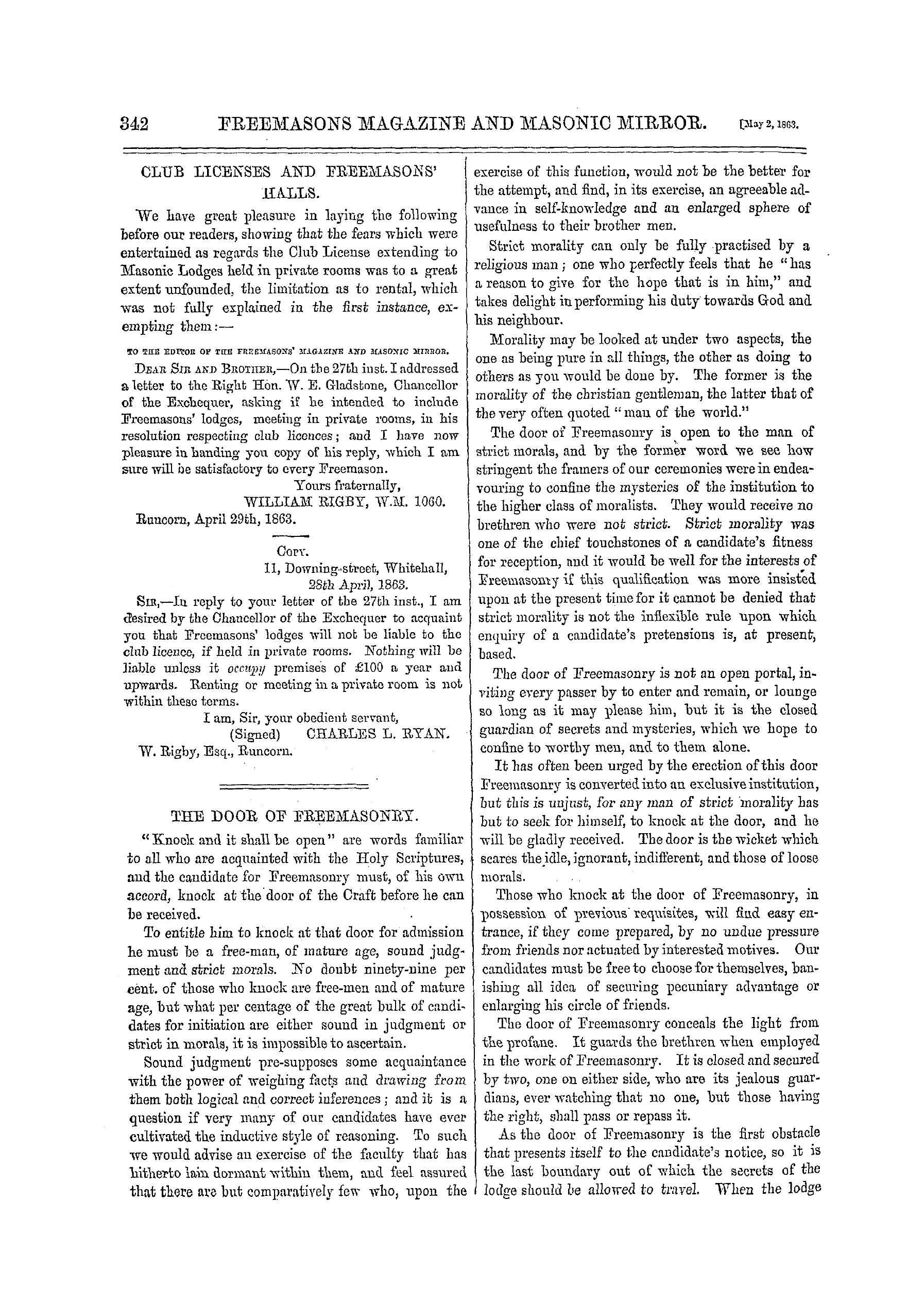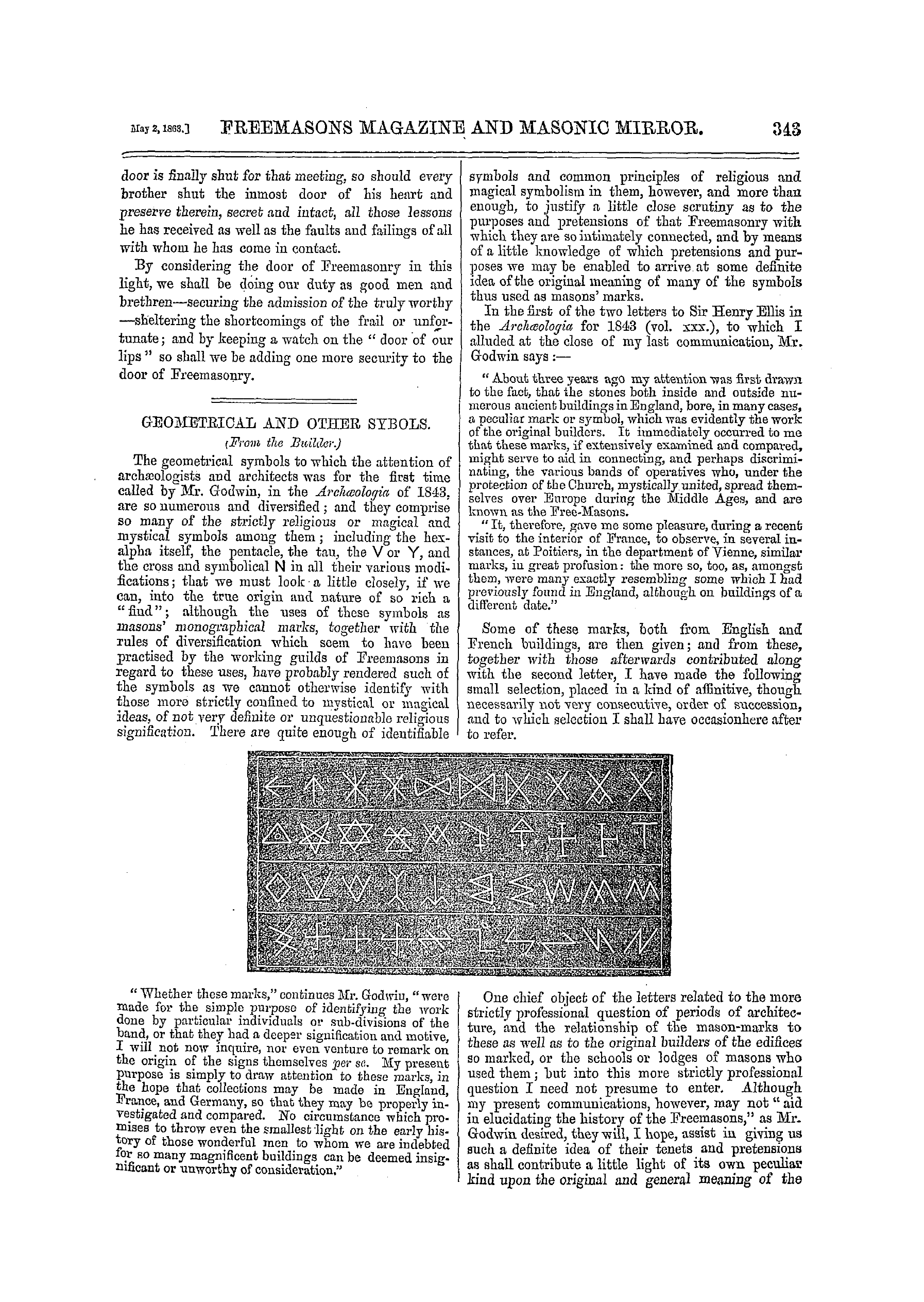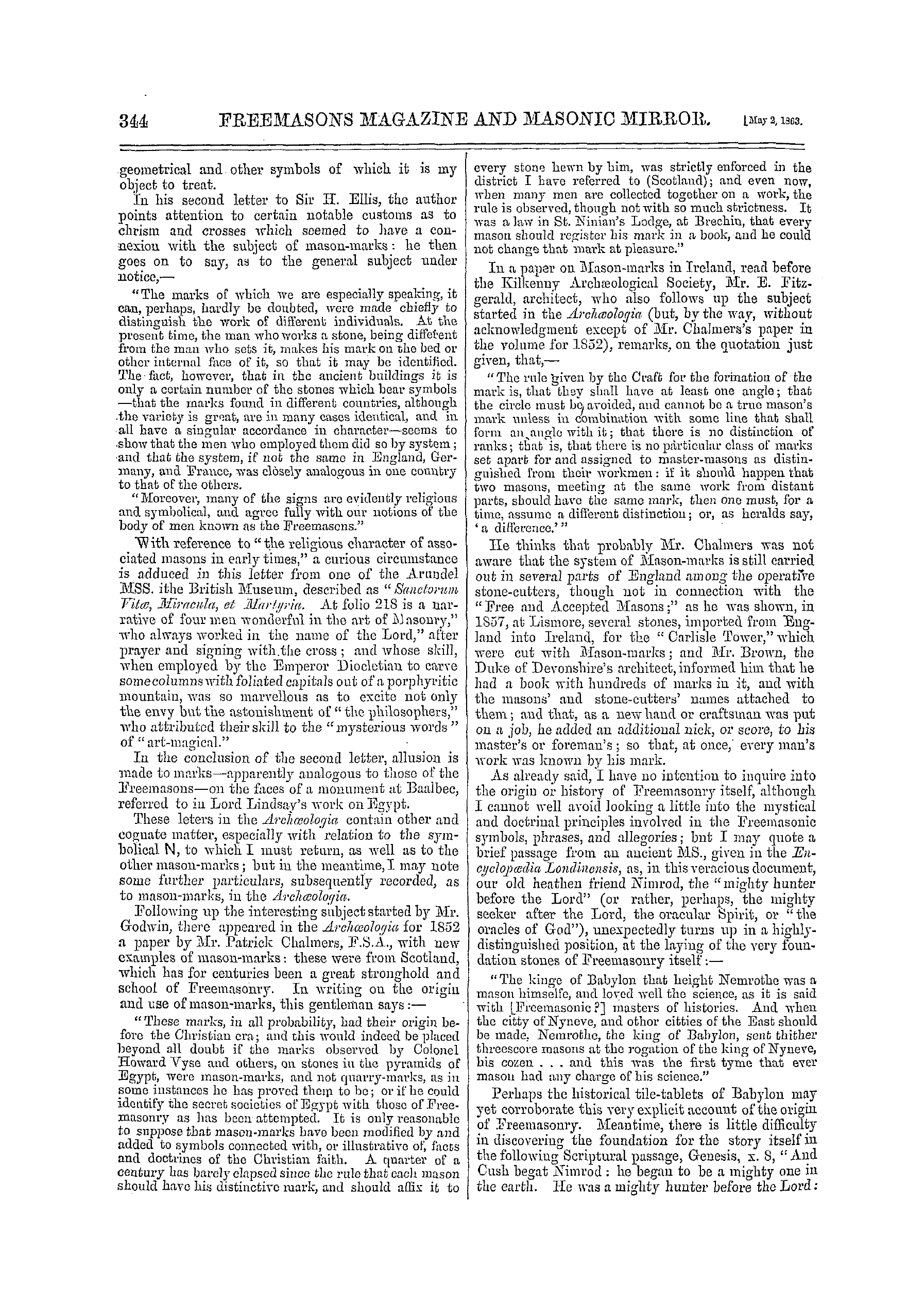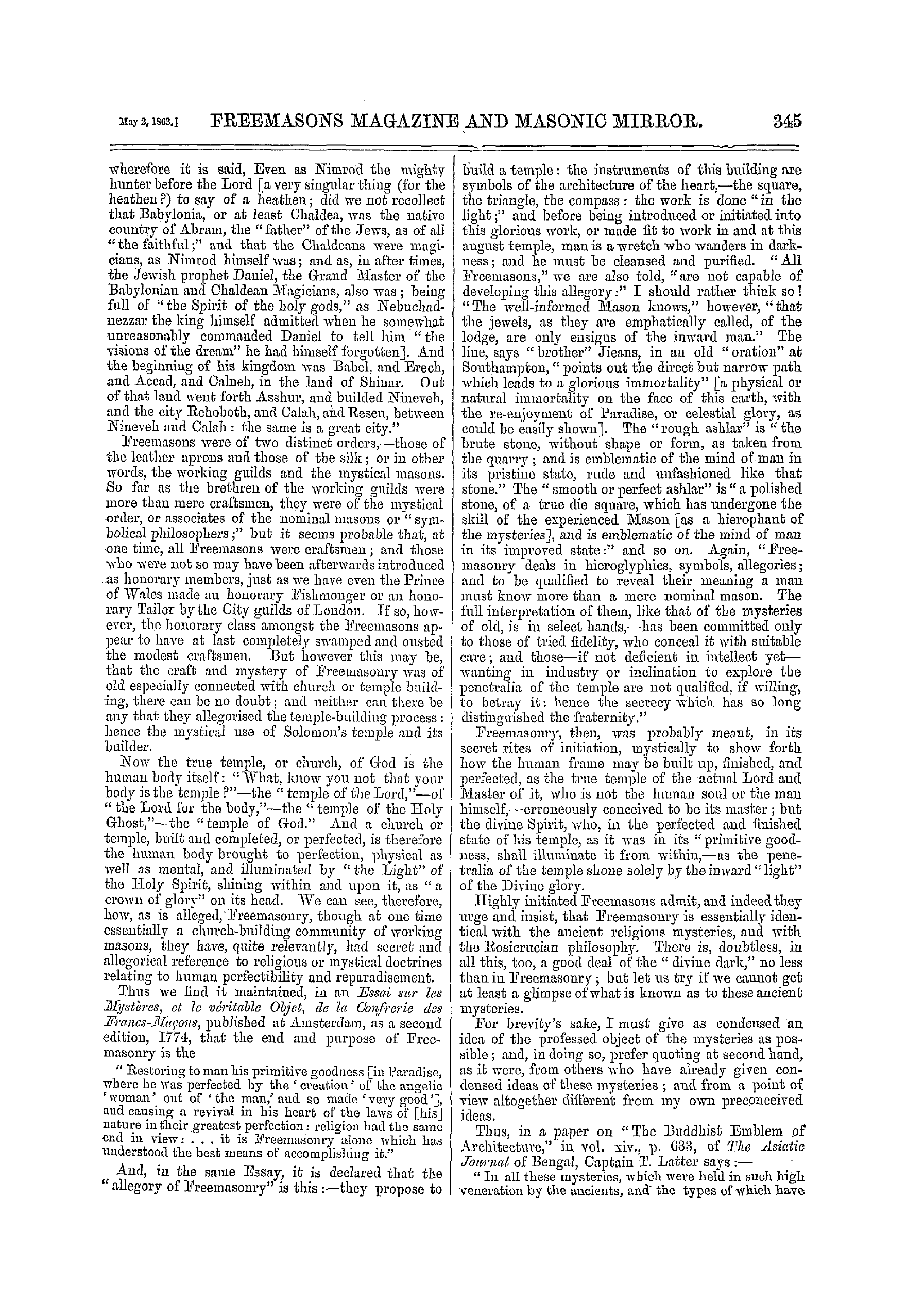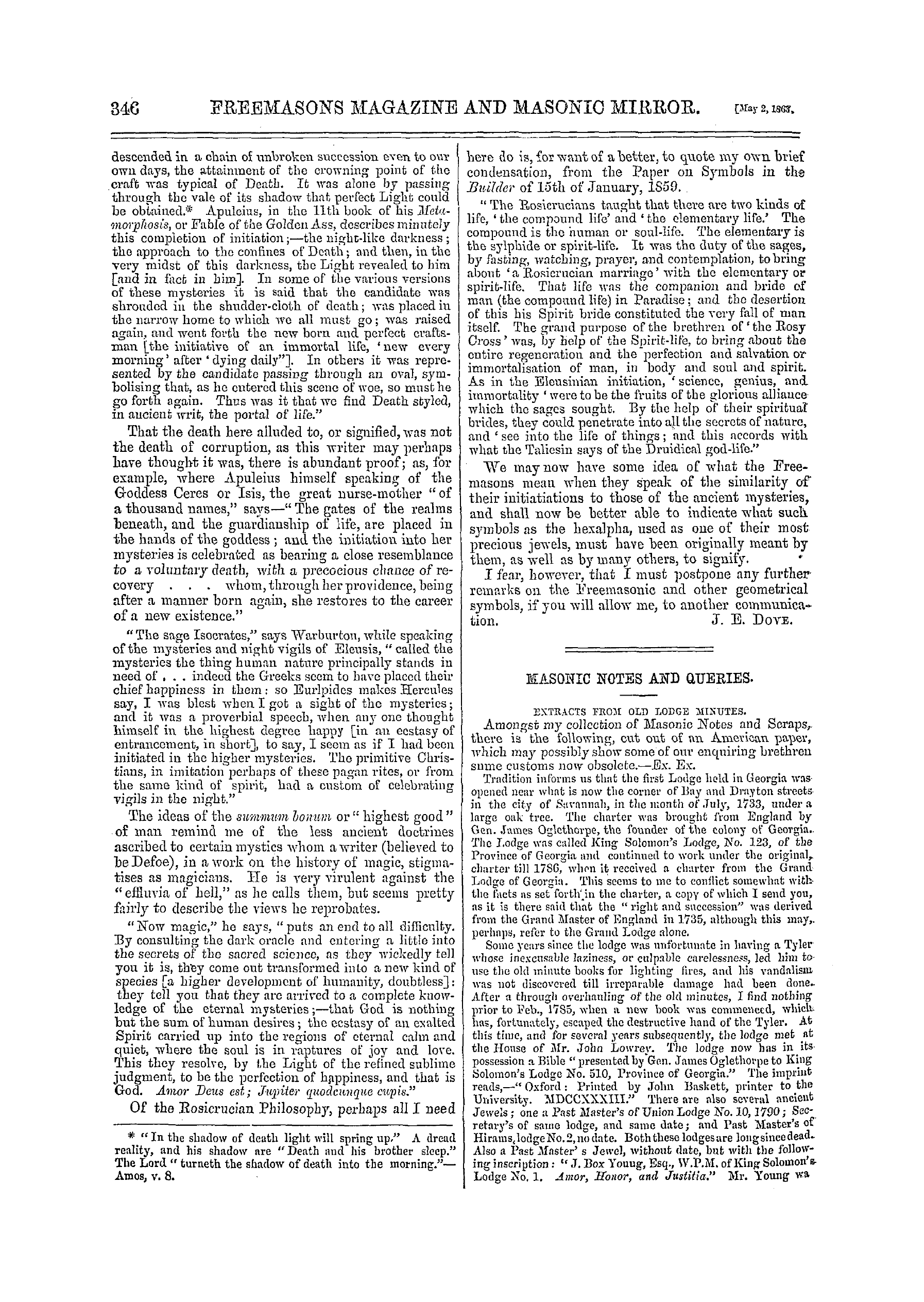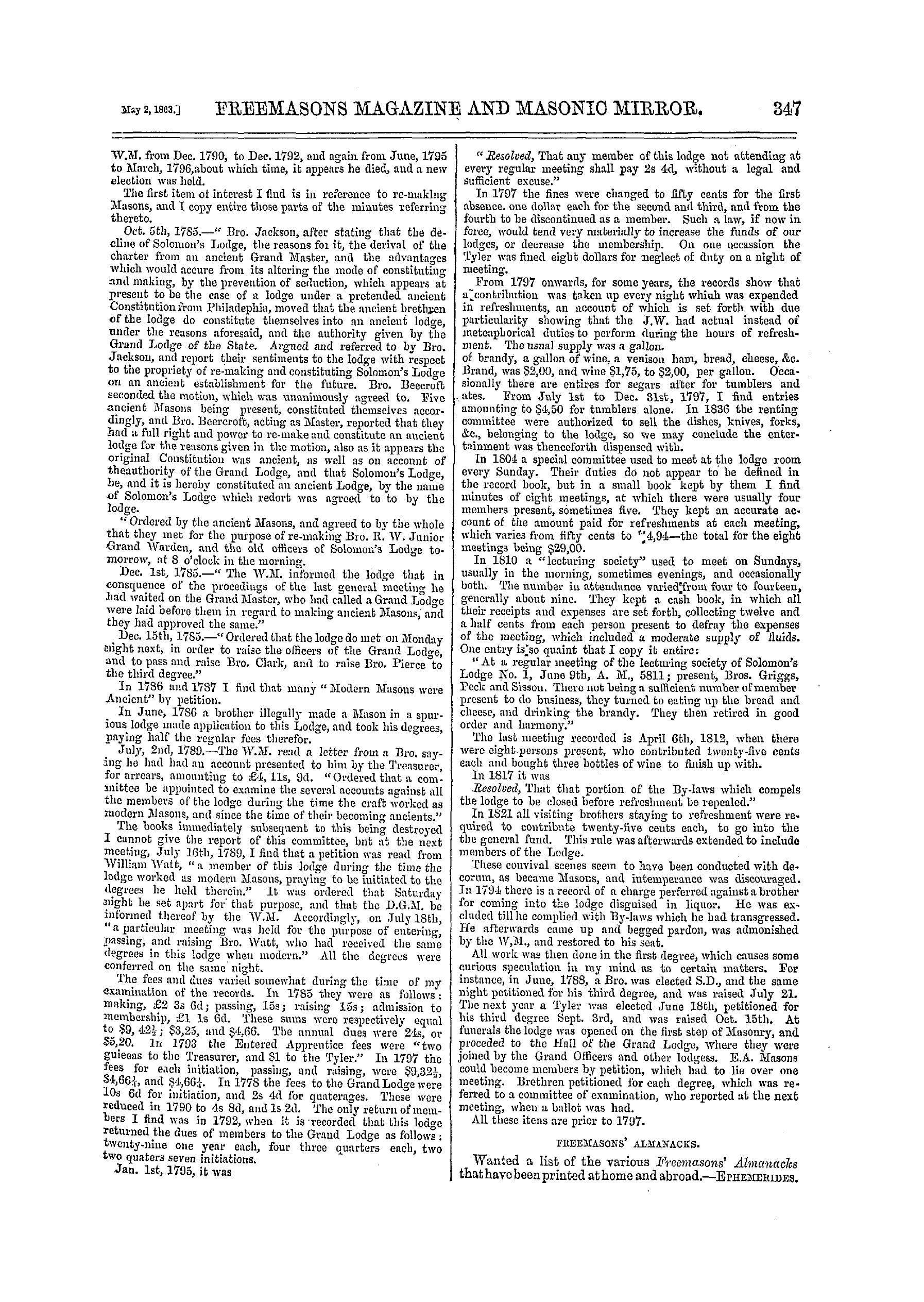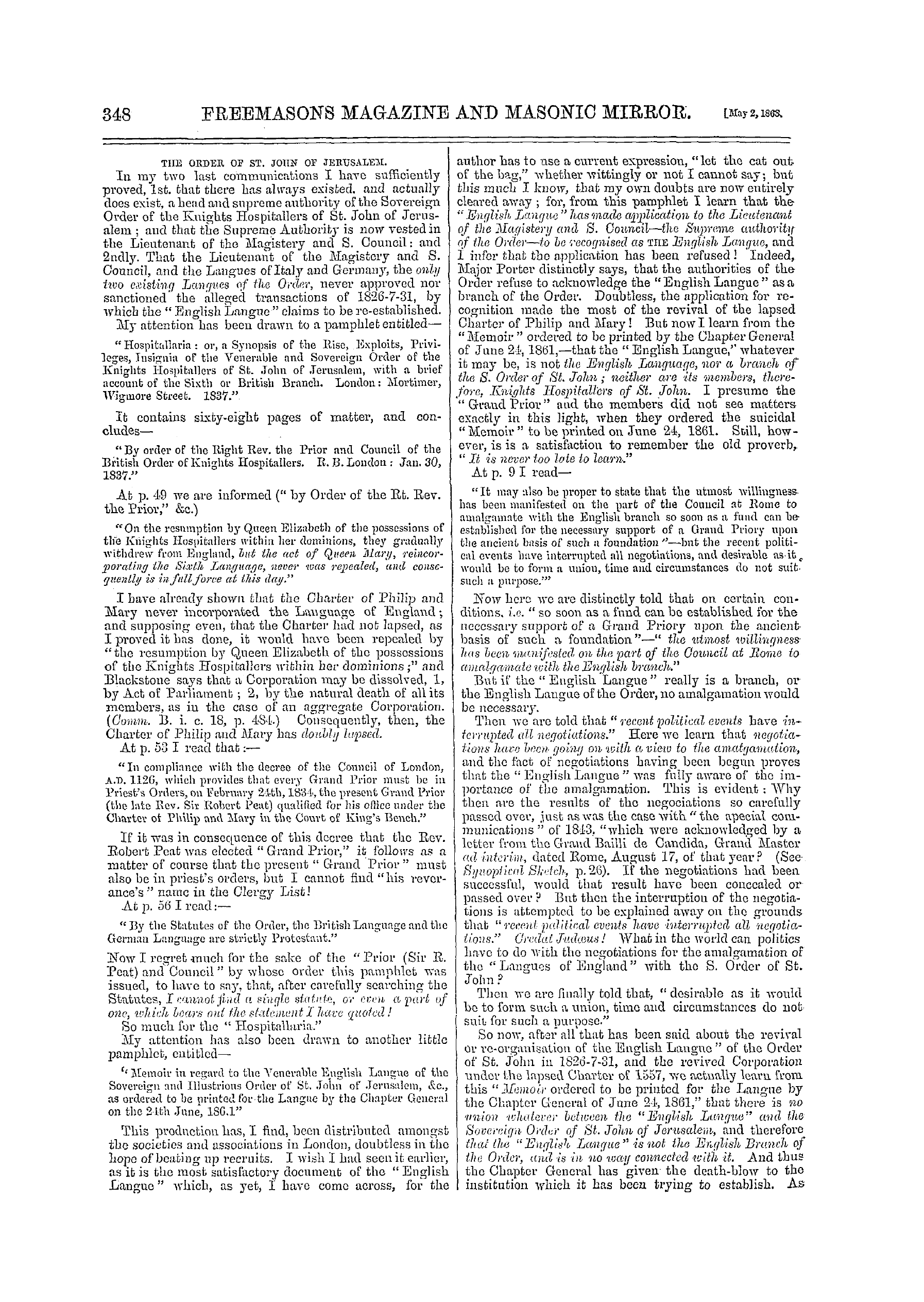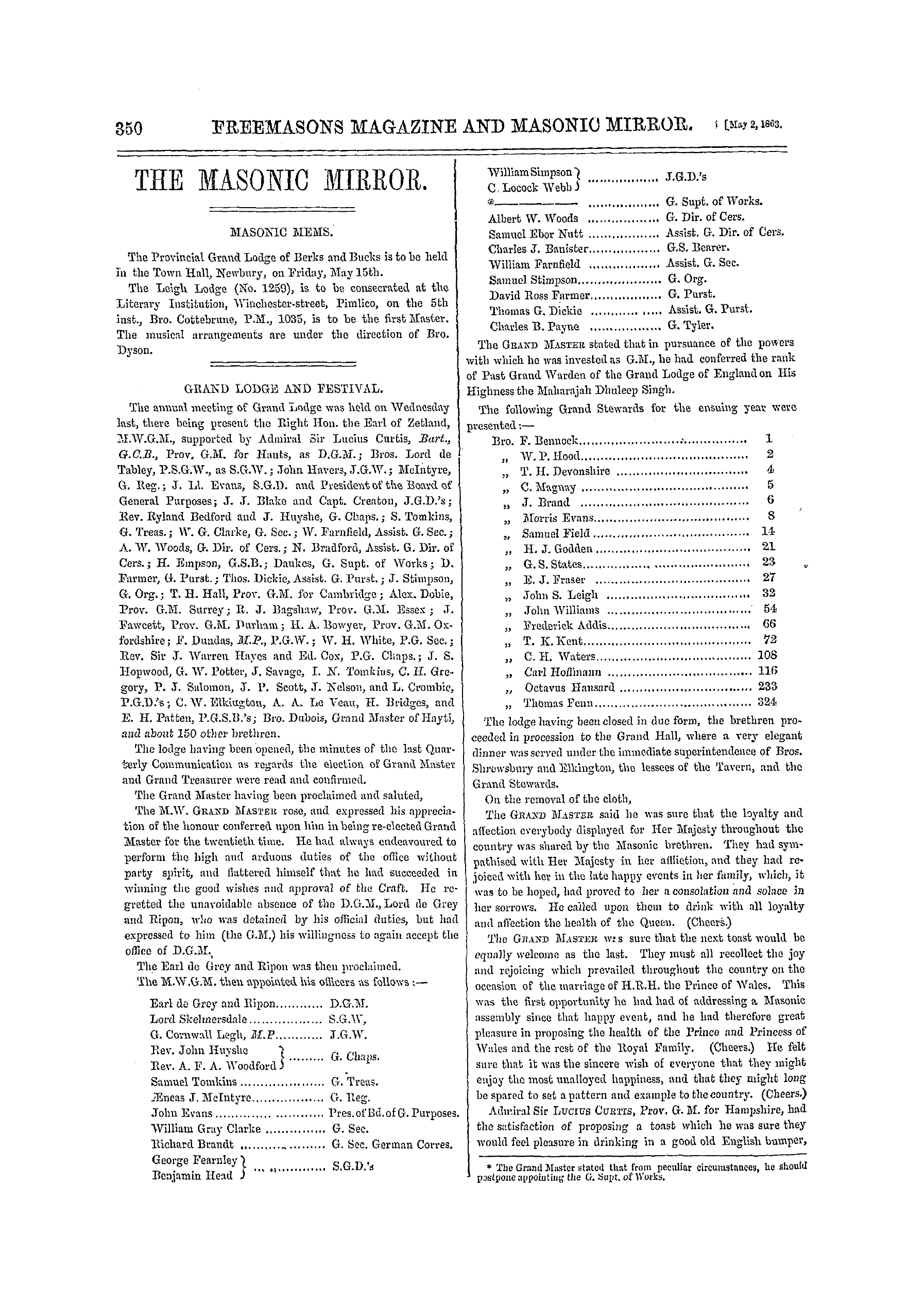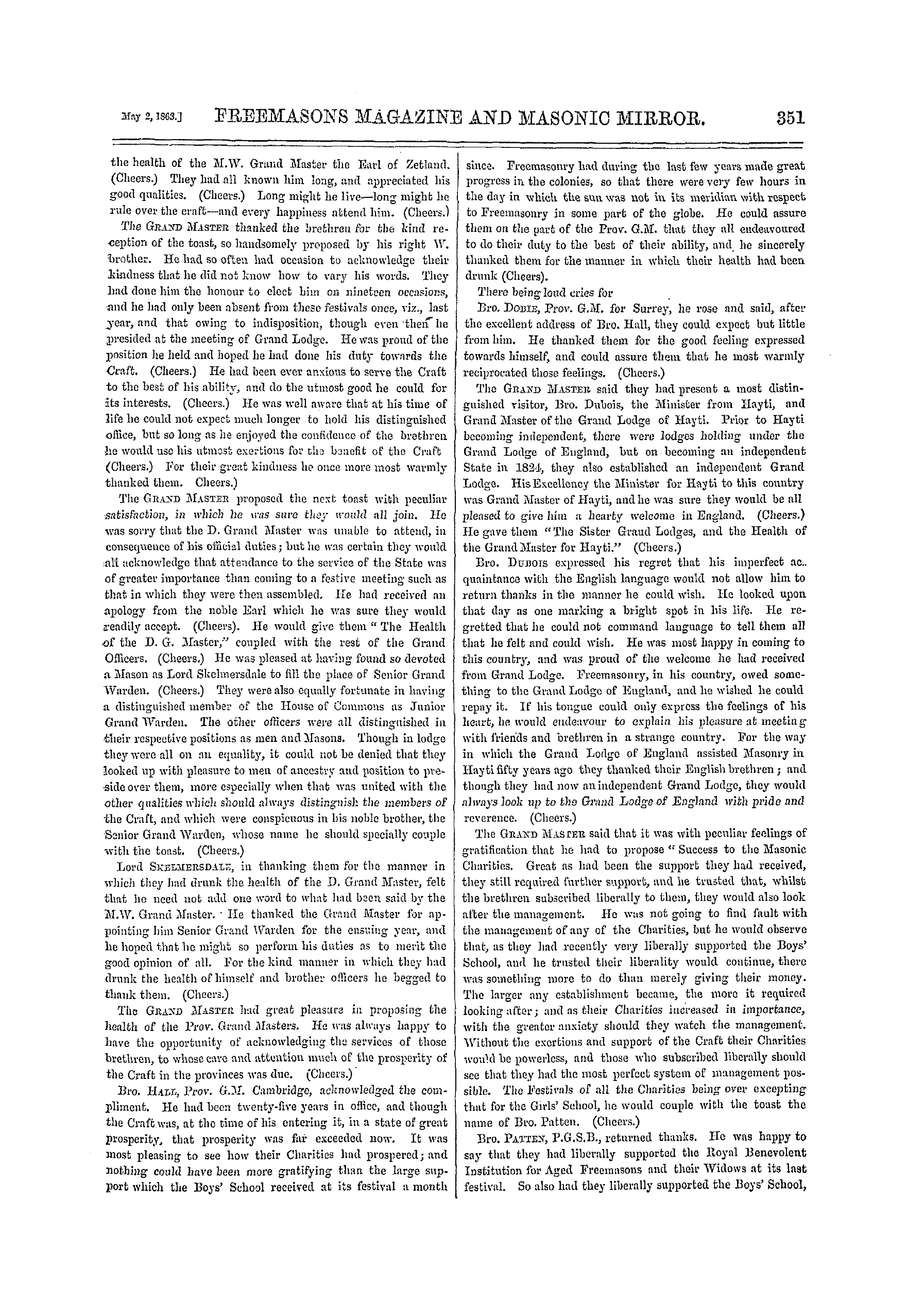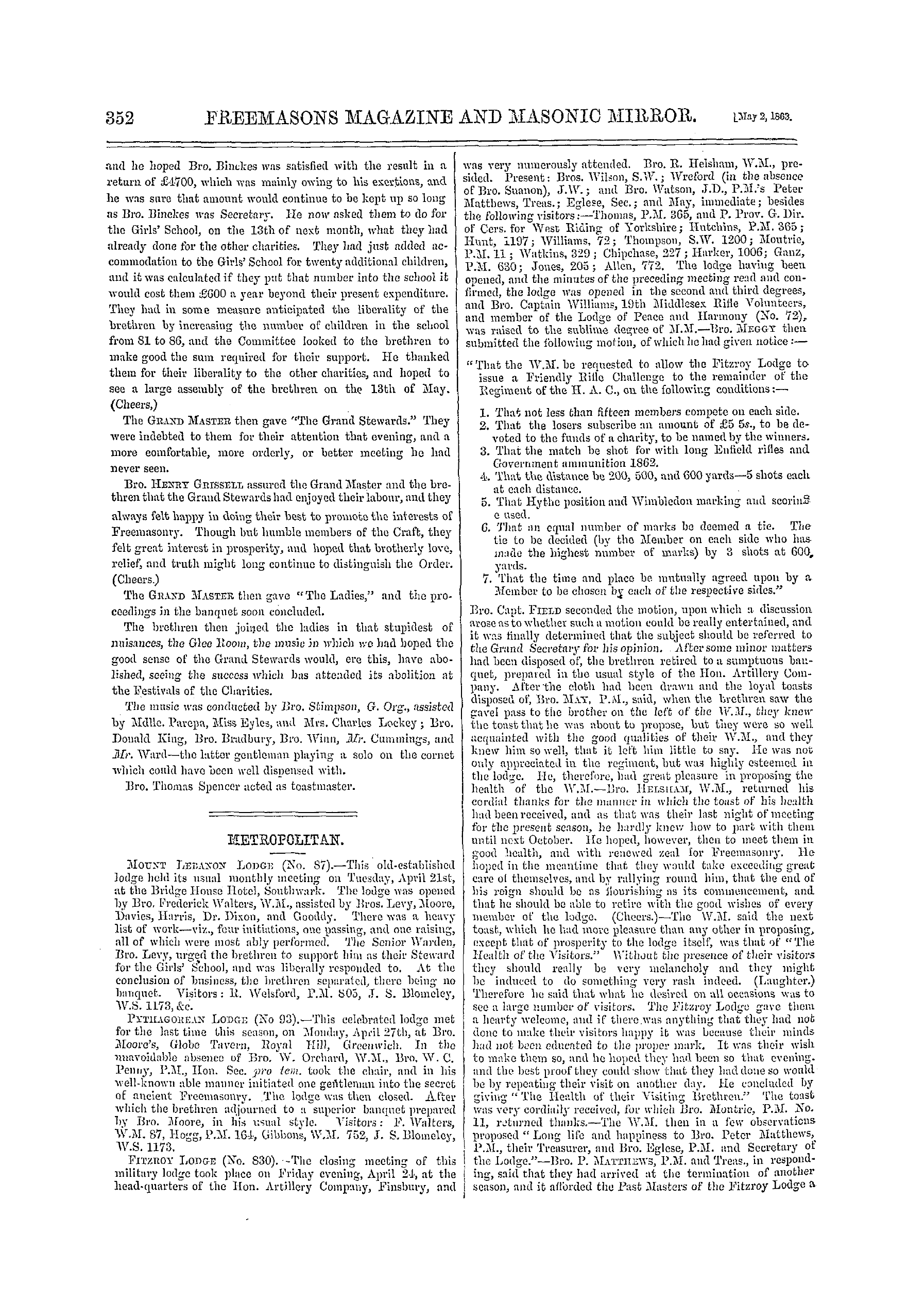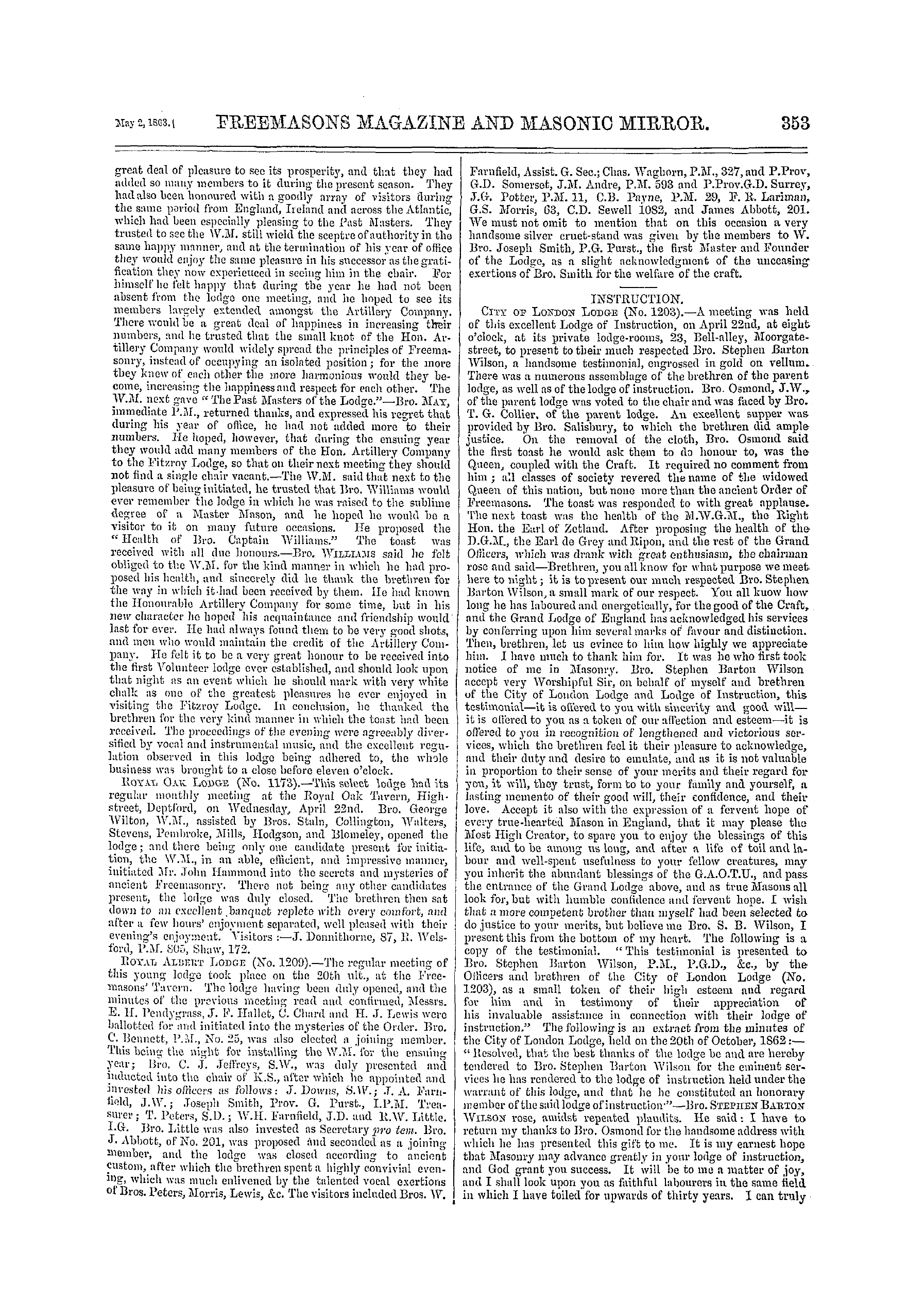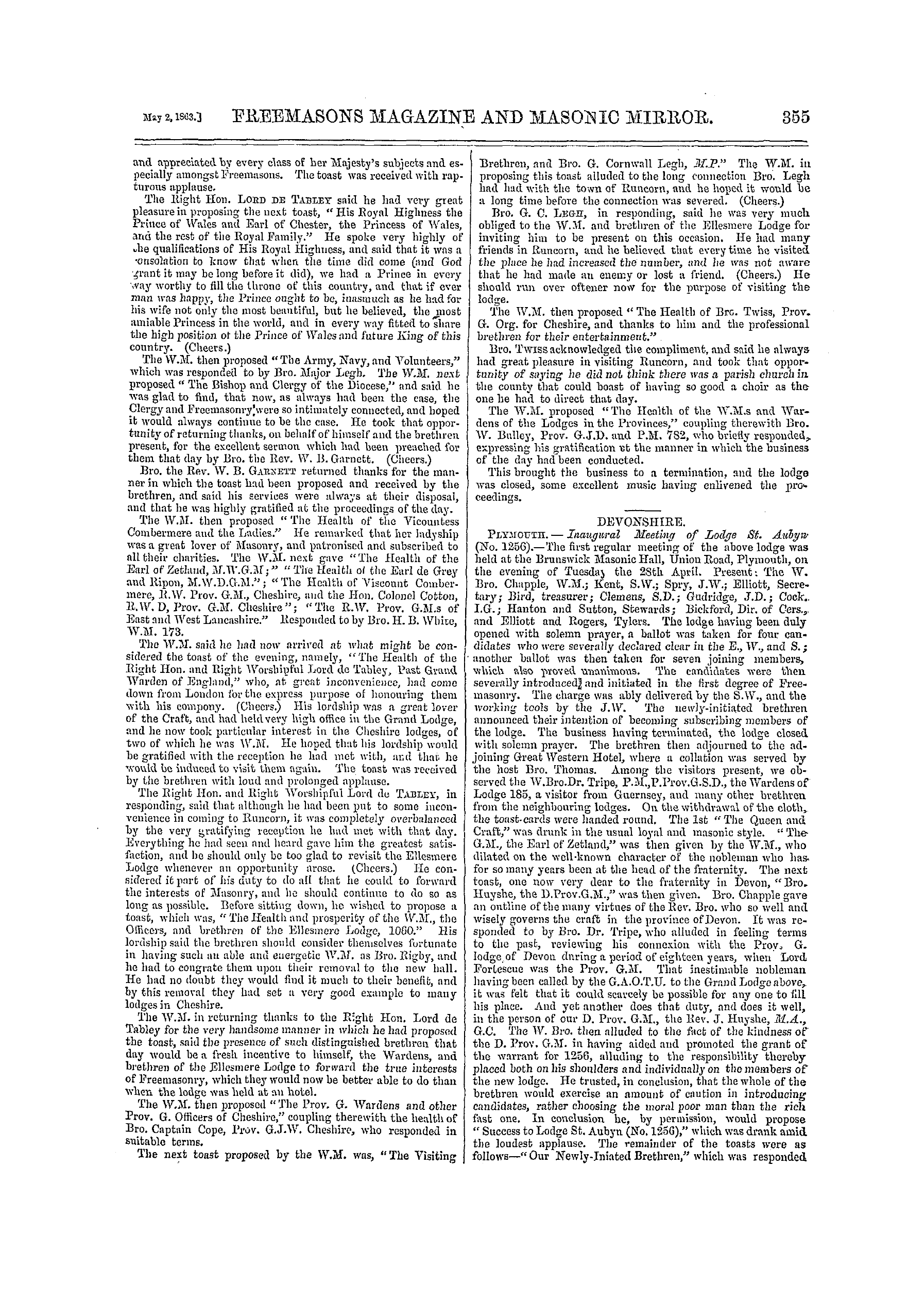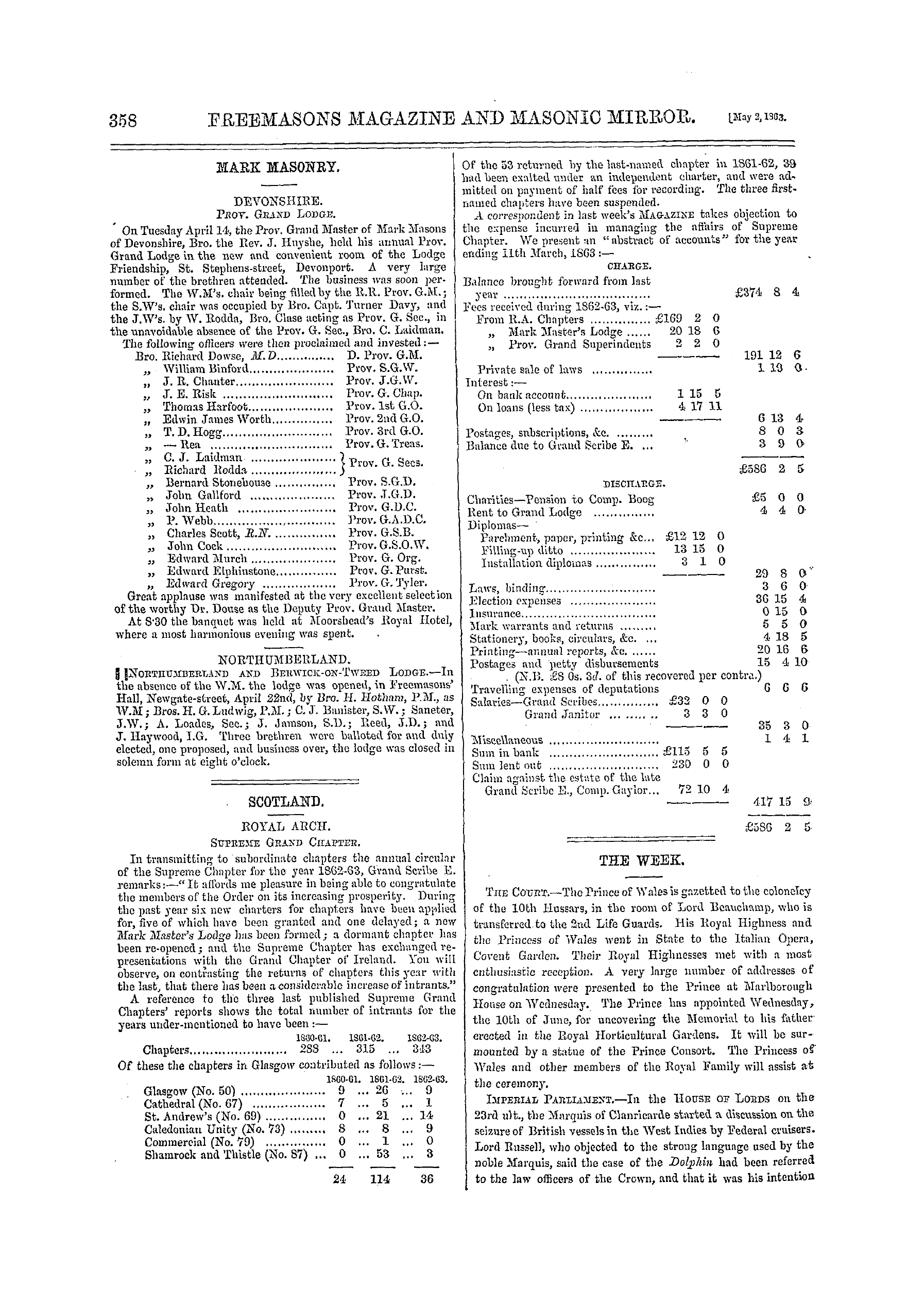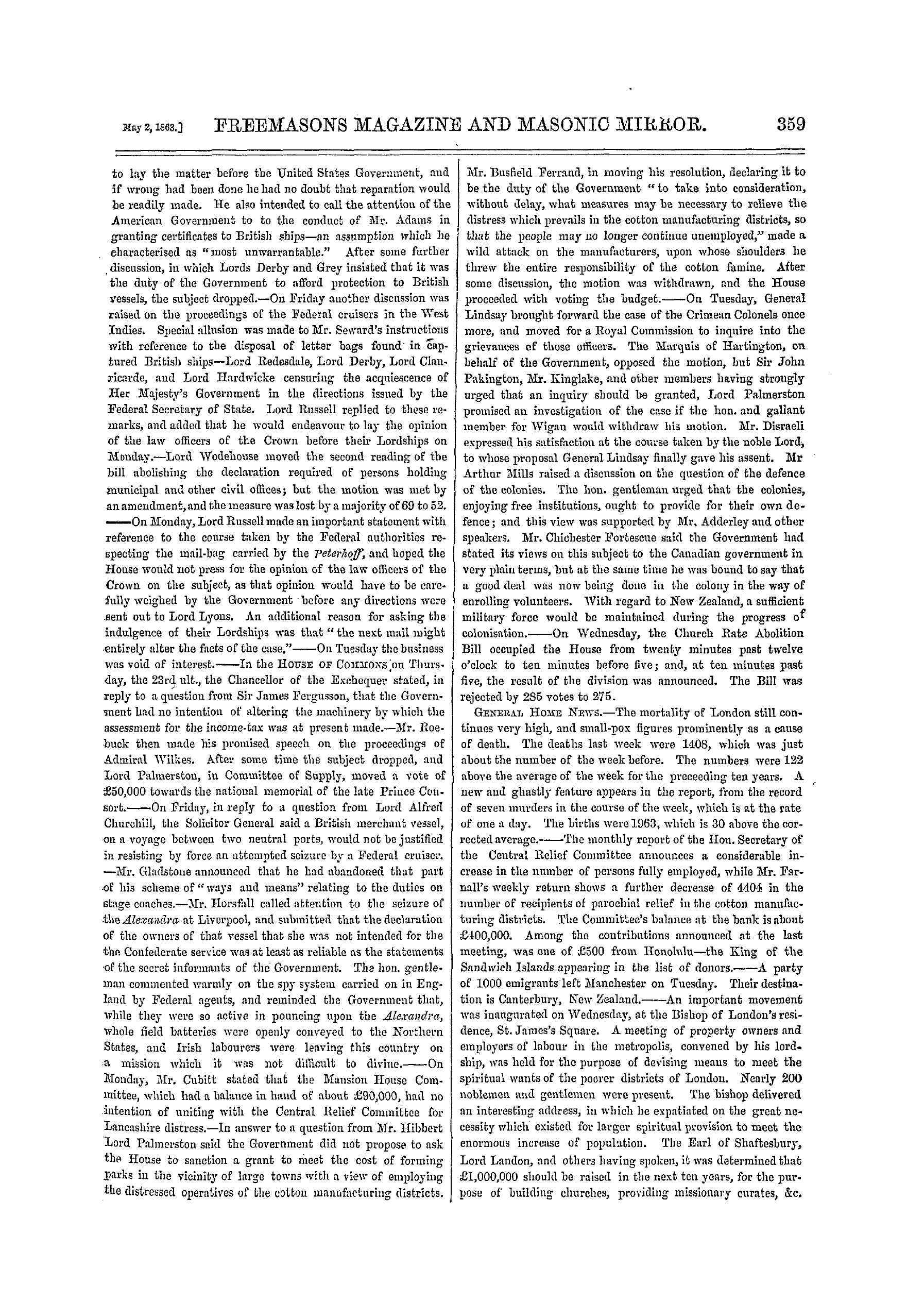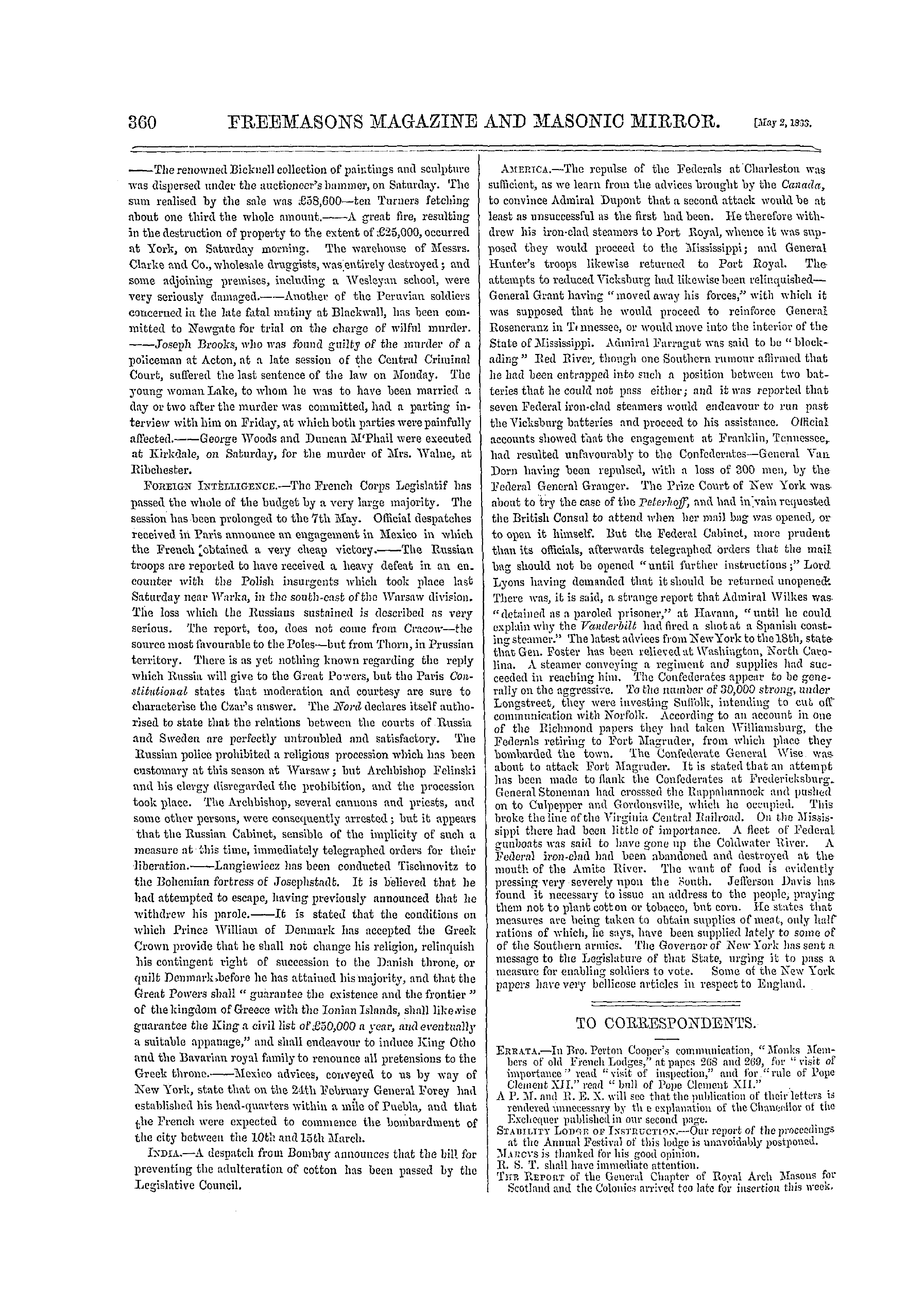-
Articles/Ads
Article GEOMETRICAL AND OTHER SYBOLS. ← Page 2 of 4 →
Note: This text has been automatically extracted via Optical Character Recognition (OCR) software.
Geometrical And Other Sybols.
geometrical and other symbols of Avhich it is my object to treat . In his second letter to Sir II . Ellis , the author points attention to certain notable customs as to chrism and crosses Avhich seemed to have a connexion with the subject of mason-marks -. he then goes on to say , as to the general subject under notice , —
" The marks of AA'hich Ave are especially speaking , it can , perhaps , hardly be doubted , Avere made chiefly to distinguish the work of different individuals . At the present time , the man who Avorks a stone , being different from the man Avho sets it , makes his mark on the bed or other internal face of it , so that it may be identified . The fact , howoA'er , that in the ancient buildings it is
only a certain number of the stones which bear symbols —that the marks found in different countries , although the variety is groat , are in many cases identical , and in all have a singular accordance in character—seems to shoAV that the men Avho employed them did so by sj'stem ; and that the system , if not the same in England , Germanyand FranceAvas closely analogous in one cormtry
, , to that of the others . " Moreover , many of the signs are evidently religious and symbolical , and agree fully with our notions of the body of men known as the Freemasons . " AVith reference to "the religious character of associated masons in early times" a curious circumstance
, is adduced in this letter from one of the Arundel MSS . ithe British Museum , described as " Sanctorum Vita , Miracirfa , et ' Marlijria . At folio 2 . 18 is a narrative of four men wonderful in the art of il nsonry , "
AA ho always Avorked in the name of the Lord , " after prayer and signing Avith . the cross ; and Avhose skill , when employed by the Emperor Diocletian to carve somecoIumnsAA-ith foliated capitals out of a porphyritic mountain , was so marvellous as to excite not only the envy but the astonishment of " the p hilosophers , "
who attributed their skill to the " mysterious words " of " art-magical . " In the conclusion of the second letter , allusion is made to marks—apparently analogous to those of the Ereemasons—on tlie faces of a monument at Baalbec , referred to in Lord Lindsay ' s work on Egypt .
These leters in the Archccoloyia contain other aud cognate matter , especially with relation to tlie symbolical N , to Avhich I must return , as Avell as to the other mason-marks ; but in the meantime , I may note some further particulars , subsequently recorded , as to mason-marks , in the Archccoloyia .
EolloAving up the interesting subject started by Mr . Godwin , there appeared in the Archccoloyia for 1852 a paper by Mr . Patrick Chalmers , E . S . A ., with UBAV examples of mason-marks : these were from Scotland , which has for centuries been a great stronghold and school of Freemasonry . In writing on the ori gin and use of mason-marks , this gentleman says : —
" These marks , m all probability , had their origin before the Christian era ; and this AA'ould indeed be placed beyond all doubt if the marks observed by Colonel Howard Vyse and others , on stones iu the pyramids of Egypt , were mason-marks , and not quarry-marks , as in some instances ho has piwcd thorn to be ; or if he could identify the secret societies of Egypt Avith those of
Freemasonry as has been attempted . It is only reasonable to suppose that mason-marks have been modified by and added to symbols connected Avith , or illustrative of , faces and doctrines of the Christian faith . A quarter of a century has barely elapsed since the rule that each mason should have his distinctiA'C mark , and should affix it to
every stone hewn by him , Avas strictly enforced m the district I have referred to ( Scotland ); and even now , when many men are collected together on a work , the rule is observed , though not with so much strictness . It Avas a law in St . Ninian ' s Lodge , at Brechin , that every mason should register his mark in a book , aud he could not change that mark at pleasure . "
In a paper on Mason-marks in Ireland , read before the Kilkenny Archaeological Society , Mr . E . Fitzgerald , architect , who also folloAvs up the subject started in the Archccoloyia ( but , by the way , Avithout acknoAA'ledgment except of Mr . Chalmers ' s paper in the volume for 1852 ) , remarks , on the quotation just
given , that , — "The rule " given by the Craft for the formation of the mark is , that thsy shall have at least one angle ; that the circle must he , avoided , and cannot be a true mason ' s mark unless in combination with some line that shall form an lo Avith itthat tbcre is no distinction of
^ ang ; ranks ; that is , that there is no particular class of marks set apart for and assigned to master-masons as distinguished from their Avorkmen : if it . should happen that two masons , meeting at the same work from distant parts , should have the same mark , then one must , for a time , assume a different distinction ; or , as heralds say , ' a difference . '"
He thinks that probably Mr . Chalmers was not aware that the system of Mason-marks is still carried out in several parts of England among the operative stone-cutters , though not in connection with the " Eree and Accepted Masons ; " as he Avas shown , in 1 S 57 , at Lismore , several stones , imported from
England into Ireland , for the " Carlisle ToAver , " AA'hich were cut with Mason-marks ; and Mr . BI-OAATI , the Duke of Devonshire ' s architect , informed him that he had a book with hundreds of marks in it , and with the masons' and stone-cutters' names attached to them ; aud that , as a new hand or craftsman was put
on a job , he added an additional nick , or score , to his master ' s or foreman ' s ; so that , at once , ' every man ' s work Avas known by his mark . As already said , I have no intention to inquire into the origin or history of Freemasonry itself , although I cannot well avoid looking a little into the mystical
and doctrinal principles involved in tlie Freeinasonic symbols , phrases , and allegories ; but I may quote a brief passage from an ancient MS ., given in the JSncyclofjccdia Londincnsis , as , in this veracious document , our old heathen friend Nimrod , tlie " mi ghty hunter before the Lord" ( or rather , perhapsthe mighty
, seeker after the Lord , the oracular Spirit , or " the oracles of God" ) , unexpectedly turns up in a highlydistinguished position , at the laying of the very foundation stones of Ereemasonry itself : —
" The kinge of Babylon that height Nemrothe was a mason himselfe , and loved Avell tho science , as it is said with [ Freemasonic ?] masters of histories . And when the citty of Nyneve , and othor citties ofthe East should be made , Nemrofchc , the king of Babylon , sent thither threescore masons at the rogation of the king of Nyneve , his cozen . . . and this was the first tyme that ever
mason had any charge of his science . " Perhaps the historical tile-tablets of Babylon may yet corroborate this very explicit account of the orig in of Ereemasonry . Meantime , there is little difficulty in discovering the foundation for the story itself in the following Scriptural passage , Genesis , x . 8 , " And Cush begat Nimrod : he began to be a mig hty one in the earth . He AA ' as a mighty hunter before the Lord
Note: This text has been automatically extracted via Optical Character Recognition (OCR) software.
Geometrical And Other Sybols.
geometrical and other symbols of Avhich it is my object to treat . In his second letter to Sir II . Ellis , the author points attention to certain notable customs as to chrism and crosses Avhich seemed to have a connexion with the subject of mason-marks -. he then goes on to say , as to the general subject under notice , —
" The marks of AA'hich Ave are especially speaking , it can , perhaps , hardly be doubted , Avere made chiefly to distinguish the work of different individuals . At the present time , the man who Avorks a stone , being different from the man Avho sets it , makes his mark on the bed or other internal face of it , so that it may be identified . The fact , howoA'er , that in the ancient buildings it is
only a certain number of the stones which bear symbols —that the marks found in different countries , although the variety is groat , are in many cases identical , and in all have a singular accordance in character—seems to shoAV that the men Avho employed them did so by sj'stem ; and that the system , if not the same in England , Germanyand FranceAvas closely analogous in one cormtry
, , to that of the others . " Moreover , many of the signs are evidently religious and symbolical , and agree fully with our notions of the body of men known as the Freemasons . " AVith reference to "the religious character of associated masons in early times" a curious circumstance
, is adduced in this letter from one of the Arundel MSS . ithe British Museum , described as " Sanctorum Vita , Miracirfa , et ' Marlijria . At folio 2 . 18 is a narrative of four men wonderful in the art of il nsonry , "
AA ho always Avorked in the name of the Lord , " after prayer and signing Avith . the cross ; and Avhose skill , when employed by the Emperor Diocletian to carve somecoIumnsAA-ith foliated capitals out of a porphyritic mountain , was so marvellous as to excite not only the envy but the astonishment of " the p hilosophers , "
who attributed their skill to the " mysterious words " of " art-magical . " In the conclusion of the second letter , allusion is made to marks—apparently analogous to those of the Ereemasons—on tlie faces of a monument at Baalbec , referred to in Lord Lindsay ' s work on Egypt .
These leters in the Archccoloyia contain other aud cognate matter , especially with relation to tlie symbolical N , to Avhich I must return , as Avell as to the other mason-marks ; but in the meantime , I may note some further particulars , subsequently recorded , as to mason-marks , in the Archccoloyia .
EolloAving up the interesting subject started by Mr . Godwin , there appeared in the Archccoloyia for 1852 a paper by Mr . Patrick Chalmers , E . S . A ., with UBAV examples of mason-marks : these were from Scotland , which has for centuries been a great stronghold and school of Freemasonry . In writing on the ori gin and use of mason-marks , this gentleman says : —
" These marks , m all probability , had their origin before the Christian era ; and this AA'ould indeed be placed beyond all doubt if the marks observed by Colonel Howard Vyse and others , on stones iu the pyramids of Egypt , were mason-marks , and not quarry-marks , as in some instances ho has piwcd thorn to be ; or if he could identify the secret societies of Egypt Avith those of
Freemasonry as has been attempted . It is only reasonable to suppose that mason-marks have been modified by and added to symbols connected Avith , or illustrative of , faces and doctrines of the Christian faith . A quarter of a century has barely elapsed since the rule that each mason should have his distinctiA'C mark , and should affix it to
every stone hewn by him , Avas strictly enforced m the district I have referred to ( Scotland ); and even now , when many men are collected together on a work , the rule is observed , though not with so much strictness . It Avas a law in St . Ninian ' s Lodge , at Brechin , that every mason should register his mark in a book , aud he could not change that mark at pleasure . "
In a paper on Mason-marks in Ireland , read before the Kilkenny Archaeological Society , Mr . E . Fitzgerald , architect , who also folloAvs up the subject started in the Archccoloyia ( but , by the way , Avithout acknoAA'ledgment except of Mr . Chalmers ' s paper in the volume for 1852 ) , remarks , on the quotation just
given , that , — "The rule " given by the Craft for the formation of the mark is , that thsy shall have at least one angle ; that the circle must he , avoided , and cannot be a true mason ' s mark unless in combination with some line that shall form an lo Avith itthat tbcre is no distinction of
^ ang ; ranks ; that is , that there is no particular class of marks set apart for and assigned to master-masons as distinguished from their Avorkmen : if it . should happen that two masons , meeting at the same work from distant parts , should have the same mark , then one must , for a time , assume a different distinction ; or , as heralds say , ' a difference . '"
He thinks that probably Mr . Chalmers was not aware that the system of Mason-marks is still carried out in several parts of England among the operative stone-cutters , though not in connection with the " Eree and Accepted Masons ; " as he Avas shown , in 1 S 57 , at Lismore , several stones , imported from
England into Ireland , for the " Carlisle ToAver , " AA'hich were cut with Mason-marks ; and Mr . BI-OAATI , the Duke of Devonshire ' s architect , informed him that he had a book with hundreds of marks in it , and with the masons' and stone-cutters' names attached to them ; aud that , as a new hand or craftsman was put
on a job , he added an additional nick , or score , to his master ' s or foreman ' s ; so that , at once , ' every man ' s work Avas known by his mark . As already said , I have no intention to inquire into the origin or history of Freemasonry itself , although I cannot well avoid looking a little into the mystical
and doctrinal principles involved in tlie Freeinasonic symbols , phrases , and allegories ; but I may quote a brief passage from an ancient MS ., given in the JSncyclofjccdia Londincnsis , as , in this veracious document , our old heathen friend Nimrod , tlie " mi ghty hunter before the Lord" ( or rather , perhapsthe mighty
, seeker after the Lord , the oracular Spirit , or " the oracles of God" ) , unexpectedly turns up in a highlydistinguished position , at the laying of the very foundation stones of Ereemasonry itself : —
" The kinge of Babylon that height Nemrothe was a mason himselfe , and loved Avell tho science , as it is said with [ Freemasonic ?] masters of histories . And when the citty of Nyneve , and othor citties ofthe East should be made , Nemrofchc , the king of Babylon , sent thither threescore masons at the rogation of the king of Nyneve , his cozen . . . and this was the first tyme that ever
mason had any charge of his science . " Perhaps the historical tile-tablets of Babylon may yet corroborate this very explicit account of the orig in of Ereemasonry . Meantime , there is little difficulty in discovering the foundation for the story itself in the following Scriptural passage , Genesis , x . 8 , " And Cush begat Nimrod : he began to be a mig hty one in the earth . He AA ' as a mighty hunter before the Lord

